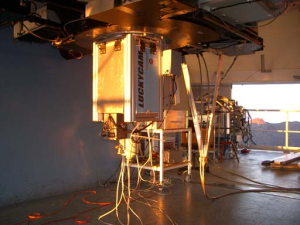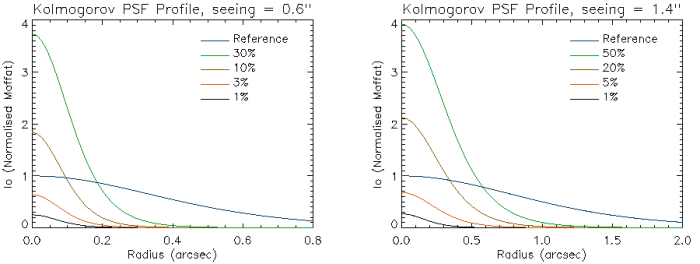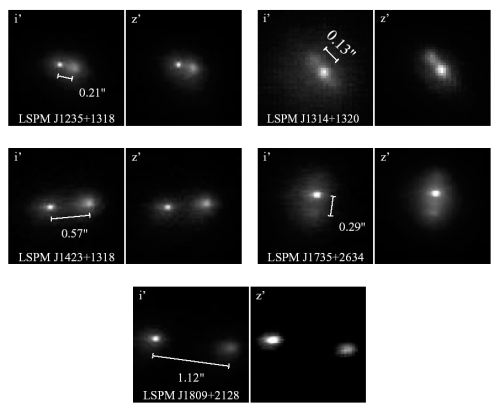
LuckyCam The lucky imaging camera system
Lucky imaging greatly improves the resolution of images in the longer
visible wavelengths, with the NOT, even to the diffraction limit of
the full NOT aperture. With the current LuckyCam at wavelengths as
short as H As a consequence of numerous refinements to the camera system involving both the hardware and software interface it is essentially possible to operate the LuckyCam as a normal direct imaging system, though to date it has always been operating in service mode. The current Lucky Imaging camera is substantially different from that used previously on the NOT. Firstly it now uses an array of four electron multiplying (photon counting) CCDs in a line giving a contiguous imaging area of 4000 x 1000 pixels. An important innovation is the inclusion of the ability to see in real-time the image building up on the screen, though incorporating a less stringent sampling criteria to that used in the data post processing. The camera can presently provide four fields-of-view (FOV) by the insertion of some simple reimaging optics, the FOV are approximately 360" x 90", 180" x 45", 120" x 30" and 90" x 22.5". The isoplanatic patch size was found in earlier runs to be > 1 arc minute diameter, and the team believe they have developed methods to extend this further. Using the larger plate scales does result in a small decrease in achievable resolution: pixel sizes are 0.1", 0.05", 0.033" and 0.025" respectively. The Lucky Imaging method relies on taking images at high speed, analysing the images to select the sharpest ones and then shifting and adding to give an output image with much higher resolution than a conventional slower scan CCD (such as StanCam) would record. The system uses a four thinned (back illuminated) CCD201 L3CCD manufactured by E2V, with 1024 x 1024 pixels of 13 µm square mounted within the liquid nitrogen cooled vacuum dewar at the focus of a simple reimaging camera. The CCD itself has an internal, noiseless gain mechanism allowing it to be run at high speed - so that there is essentially no readout noise and individual photons are clearly visible in the output data frames. If the camera is run in full frame mode then the readout rate is 20-30 frames per second. Even at the fastest rate this is slightly slower than is ideal to full sample the atmospheric coherence time typically found at the NOT. For the very best imaging performance the camera may be run in a reduced frame mode to give faster readout rates. We can record data to disk continuously for the entire night if necessary. The system can be run in a reduced frame rate reading out (for example) 4000 x 500 pixels at twice the full frame rates.
The observations are most easily done in the far red and we typically
work in I band and generally longer than 700 nm, though as mentioned
above good results have also been obtained at wavelengths as short as
H Because of the complexities involved in data reduction and image selection we would propose that we pass the data through our data processing pipeline before giving the reduced data to the observer. Naturally the original raw data would also be available but potential users should be warned that we take approximately 1GB of data in 8 seconds so disks fill up horrendously quickly. We predict data volumes of about 3 Terabytes per night. Lucky Imaging has been extensively tested between 2000-2008 and can reliably achieve the resolution improvements detailed above. Potential users who would like to find out more about this technique will find an excellent review of Lucky imaging described in "Lucky Imaging: High Angular Resolution Imaging in the Visible from the Ground", N. M. Law, C. D. Mackay, J. E. Baldwin, A&A 446, 739-745 (2006), or for even more information on what we have achieved so far might wish to look at the Lucky Imaging Web Site at Lucky web site . The Lucky imaging camera team would be happy to work with other astronomers who wish to use LuckyCam on the NOT in 2009 - and we welcome the chance to collaborate with such astronomers should they wish. We will also be happy to discuss with them their observing programme and whether changes or improvements might be advisable. In the first instance please contact Craig Mackay.
Examples of what potentially can be obtained from LuckyCam

|
||||||||||||||||||||||||||||||||||||||
| ||||||||||||||||||||||||||||||||||||||
